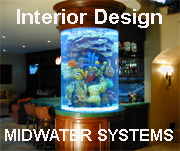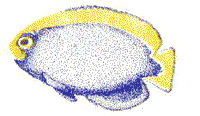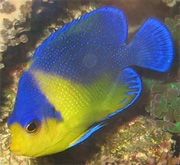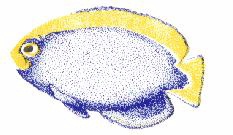|
The Annelids: Their Biology
By. Jim Wolf C.S.U.N. Marine Biologist
The phylum Annelida contains the segmented worm-like animals. Leeches
and earthworms are familiar, if not disgusting relatives of Polychaetes,or
sea worms. There are over 10,000 species of sea worms, the most familiarof
which to the hobbyist are the feather duster worms.
Polychaets range from microscopic filter feeders to 2 foot long predators
with powerful jaws. In a well established reef aquarium there could easily
be thousandsof these worms living in the rocks and gravel! One curious
inhabitant is the "Spaghetti Worm". This animal uses its elongate tentaclesto
collect detritus and bring it towards its mouth. It may have hundreds of
these tentacles and so resemble a plate of spaghetti!
The familiar Feather Duster and Christmas Tree worms belong to a few
families of sea worms that use their modified antennae to filter food from
the water. If you look closely at the base of the "feathers", you can usually
see smaller unmodified antennae.Most duster worms will do well on a diet
of liquid invertebrate food. When you get you feather duster home, acclimate
it slowly, and place the animal in an area of low light and modest flow.
You can place the tube into the rocks or sand with only the open end of
the tube visible. The animal should expand its crown, and start feeding
with in a few hours. Be gentle when handling the tube, as the worm living
within it is quite fragile.
Occasionally the worm may vacate its tube or drop its feeding crown.These
are usually normal parts of the organisms biology. In a few weeks it will
regenerate a new crown, and if you place the worm in a protected environment,
it will soon secrete a new tube to live in! Under optimum conditions, these
worms may actually reproduce.
Typically, the worms will shed either eggs or sperm into the water column,
and after a short perioda juvenile worm will settle and attach itself to
the substrate. Some species can reproduce by budding off new individuals,
and still others reproduce in an even more bizarre fashion. During certain
parts of the year, the adult worms will form a small copy of itself. Slowly
this copy (calledan epitoke) will fill with gametes (sex cells), and during
a full moon the epitoke will detach and swarm at the surface of the water.
Shortly after they literally explode, and shed the sex cells close to one
another,and thus insure a good chance at fertilization!!
I want to close out this article with a few extra pointers to keep your
worm happy. Avoid putting too many into one aquarium, as they will compete
for food. About one per10 gallons is a good start. Many species of fish,
crabs and some urchins will try to eat them, so proceed with caution! Avoid
placing the animal in areas of extremely intense lighting or flow, as this
may inhibit their feeding. Handle the worm gently as the tube that covers
it is flexible,and if handled too roughly you might injure your new worm!
|











